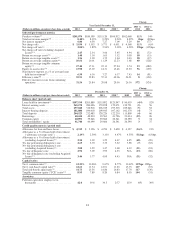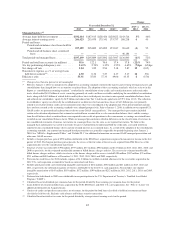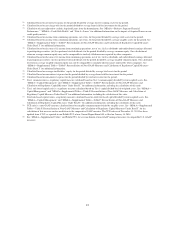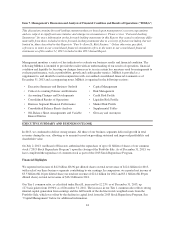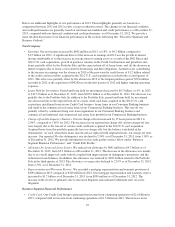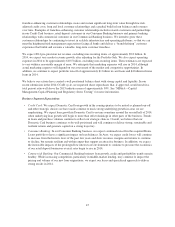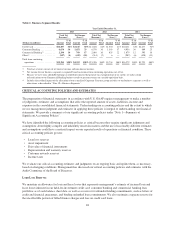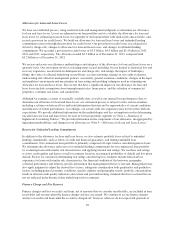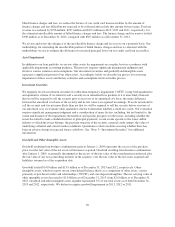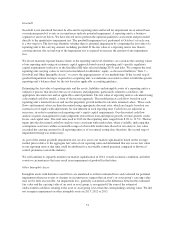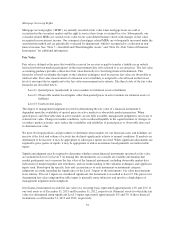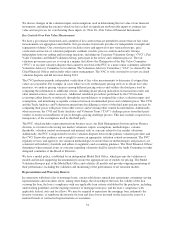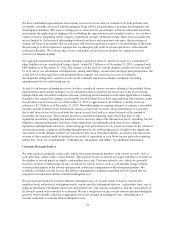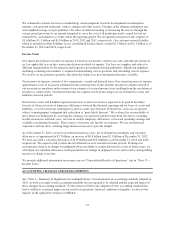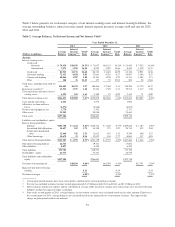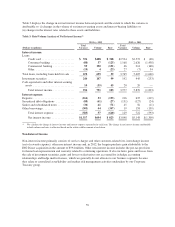Capital One 2013 Annual Report Download - page 71
Download and view the complete annual report
Please find page 71 of the 2013 Capital One annual report below. You can navigate through the pages in the report by either clicking on the pages listed below, or by using the keyword search tool below to find specific information within the annual report.Goodwill
Goodwill is not amortized but must be allocated to reporting units and tested for impairment on an annual basis
or in interim periods if events or circumstances indicate potential impairment. A reporting unit is a business
segment or one level below. We have elected not to perform the optional qualitative assessment and proceeded
directly to the quantitative impairment test. The goodwill impairment test, performed at October 1 of each year,
is a two-step test. The first step identifies whether there is potential impairment by comparing the fair value of a
reporting unit to the carrying amount, including goodwill. If the fair value of a reporting unit is less than its
carrying amount, the second step of the impairment test is required to measure the amount of any impairment
loss.
We do not maintain separate balance sheets at the reporting unit level; therefore, we calculate the carrying values
of our reporting units using an economic capital approach based on each reporting unit’s specific regulatory
capital requirements (reflective of the final Basel III rules released during 2013) and risks. We compare the total
reporting unit carrying values to our total consolidated stockholders’ equity, as discussed further in “Note 7—
Goodwill and Other Intangible Assets,” to assess the appropriateness of our methodology. If the second step of
goodwill impairment testing is required for a reporting unit, we undertake an extensive effort to build the specific
reporting unit’s balance sheet for the test based on applicable accounting guidance.
Estimating the fair value of reporting units and the assets, liabilities and intangible assets of a reporting unit is a
subjective process that involves the use of estimates and judgments, particularly related to cash flows, the
appropriate discount rates and an applicable control premium. The fair value of reporting units is calculated using
a discounted cash flow model, a form of the income approach. The model projects cash flows based on each
reporting unit’s internal forecast and use the perpetuity growth method to calculate terminal values . These cash
flows and terminal values are then discounted using appropriate discount rates, which are largely based on our
external cost of equity with adjustments for risk inherent in each reporting unit: Cash flows are adjusted, as
necessary, in order to maintain each reporting unit’s equity capital requirements. Our discounted cash flow
analysis requires management to make judgments about future loan and deposit growth, revenue growth, credit
losses, and capital rates. Discount rates used in 2013 for the reporting units ranged from 8.0% to 12.5%. The key
inputs into the discounted cash flow analysis were consistent with market data, where available, indicating that
assumptions used were within a reasonable range of observable market data. Based on our analysis, fair value
exceeded the carrying amount for all reporting units as of our annual testing date, therefore, the second step of
impairment testing was unnecessary.
As part of the annual goodwill impairment test, we also assess our market capitalization based on the average
market price relative to the aggregate fair value of our reporting units and determined that any excess fair value
in our reporting units at that time could be attributed to a reasonable control premium compared to historical
control premiums seen in the industry.
We will continue to regularly monitor our market capitalization in 2014, overall economic conditions and other
events or circumstances that may result in an impairment of goodwill in the future.
Other Intangible Assets
Intangible assets with definitive useful lives are amortized over their estimated lives and evaluated for potential
impairment whenever events or changes in circumstances suggest that an asset’s or asset group’s carrying value
may not be fully recoverable. An impairment loss, generally calculated as the difference between the estimated
fair value and the carrying value of an asset or asset group, is recognized if the sum of the estimated
undiscounted cash flows relating to the asset or asset group is less than the corresponding carrying value. We did
not recognize impairment on other intangible assets in 2013, 2012 or 2011.
51


